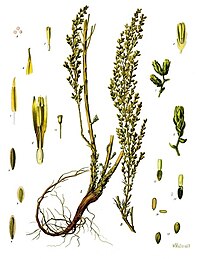
Photo from wikipedia
Silene latifolia is an herbaceous plant with great invasive potential. Spread along trade routes from Europe to almost all continents, white campion became particularly widespread in North America. We sequenced… Click to show full abstract
Silene latifolia is an herbaceous plant with great invasive potential. Spread along trade routes from Europe to almost all continents, white campion became particularly widespread in North America. We sequenced the chloroplast genome of S. latifolia subsp. alba from a native range in southeast Fennoscandia. The chloroplast genome of native S. latifolia subsp. alba forms a 151,747-bp circle, has two inverted repeat regions (25,993 bp each), large single copy (82,708 bp), and small single copy (17,106 bp) regions. It contains 77 protein-coding genes, 30 tRNA genes, and four rRNA genes. SSRs and long DNA repeats were identified. Comparison of a newly sequenced plastome of S. latifolia subsp. alba with plastomes of invasive specimens of species from North America and Japan revealed a high level of single nucleotide polymorphisms (SNPs) among them. A total of 214 SNPs were found, among which 110 were identified in intergenic spacers, 74 in exons, and 30 in introns. Intraspecific shifts in inverted repeat boundaries were identified. Our research suggests that high polymorphic regions may be potential molecular markers for population studies and that high intraspecific genetic polymorphism may contribute to a species’ invasive success.
Journal Title: Plant Molecular Biology Reporter
Year Published: 2020
Link to full text (if available)
Share on Social Media: Sign Up to like & get
recommendations!